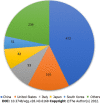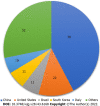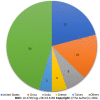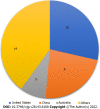Integrity of the editing and publishing process is the basis for improving an academic journal's Impact Factor
- PMID: 36483155
- PMCID: PMC9724485
- DOI: 10.3748/wjg.v28.i43.6168
Integrity of the editing and publishing process is the basis for improving an academic journal's Impact Factor
Abstract
Background: Journal Impact Factor™ (JIF) is often used to evaluate the relative reputation and quality of academic journals in their respective fields, and can greatly influence the quality and scope of subsequent manuscript submissions. Therefore, many if not all academic journals are interested in increasing their JIF, to improve their academic impact.
Aim: To determine the importance of the integrity of the editorial and publication process in improving the academic influence of academic journals and the JIF of academic journals.
Methods: In this paper, we describe our statistical analysis of bibliometric factors - including the 2021 JIFs released in the Journal Citation Report™ 2022, discipline rankings, received and published articles in 2019-2021, and webpage visits and downloads - for seven journals published by Baishideng Publishing Group (Baishideng) and indexed in Science Citation Index Expanded™; ultimately, we introduce and discuss the editing and publishing processes of Baishideng's journals in their entirety, as they form the basis for our objective of safeguarding and bolstering integrity in academic publication.
Results: For the seven journals assessed, their 2021 JIFs were basically unchanged from 2020, with the current metric ranging from 5.374 for World Journal of Gastroenterology (WJG) to 1.534 for World Journal of Clinical Cases (WJCC). Further assessments of the journals' bibliometrics from 2019 to 2020, showed that World Journal of Stem Cells has the highest self-citation rate (1.43%) and World Journal of Gastrointestinal Surgery has the lowest (0.21%). Additionally, the total 3012 articles published during this period were cited by more than 20000 articles in approximately 8000 academic journals. Of note, the 1102 articles published in WJG were cited by articles in 3059 journals, among which 171 journals have a JIF of > 10, including internationally renowned academic journals such as CA-A Cancer Journal for Clinicians (2021 JIF 286.130, record count: 1), Lancet (2021 JIF 202.731, record count: 4), Nature Reviews Immunology (2021 JIF 108.555, record count: 2), Nature Reviews Gastroenterology & Hepatology (2021 JIF 73.082, record count: 9), Lancet Gastroenterology & Hepatology (2021 JIF 45.042, record count: 8), Gastroenterology (2021 JIF 33.883, record count: 19), and Gut (2021 JIF 31.793, record count: 21). This suggests that Baishideng's journals have been widely recognized for their academic quality. In the Reference Citation Analysis (RCA) database, all seven Baishideng-published journals obtained a 2022 Journal Article Influence Index (JAII). For example, WJG has a 2022 JAII of 22.048, ranking 18th out of 102 journals in the field of gastroenterology & hepatology in the RCA, with 469909 total citations (6/102) and 21313 total articles (5/102). The numbers of manuscripts received and published in 2021 were both higher than those in 2019-2020. For example, WJCC received a total of 3650 manuscripts in 2021, which is 91.1% higher than those in 2019-2020 (average: 1910 papers/year). In 2021, WJCC published 1296 articles, representing an increase of 105.1% compared to those in 2019-2020 (average: 632 articles/year). The numbers of webpage visits and downloads received by the seven journals have increased year by year. For example, the number of total visits received by WJG in 2019-2021 was 1974052 in 2019, 2317835 in 2020 (increased by 17.4% compared with that in 2019), and 2652555 in 2021 (increased by 4.4% compared with that in 2020). The visitors were from more than 220 countries and regions worldwide, such as the United States, China, and the United Kingdom. Open access (OA) plays a vital role in improving the quality, efficiency, transparency, and integrity of academic journal publishing. From 2019 to 2021, a total of 5543 OA articles were published in the seven journals, of which 2083 (37.6%) were invited and published free-of-charge. During the same period, 1683 articles were published in WJG, and the authors were from more than 70 countries and regions. For the total 5543 articles published in the seven journals from 2019 to 2021, 3903 article quality tracking reports were received after the online publication of these articles. The quality of the articles was further evaluated through the Baishideng's article quality and author evaluation tracking system, with 4655 articles (84.0%) having received author evaluation and feedback, which contributes to tracking metrics for authors' satisfaction with the collective publication processes. From March 25, 2021 to June 28, 2022, the seven journals received a total of 424 reader evaluations and 229 letters from readers; this subsequent reader engagement demonstrates that the popularity of the published articles and the volume of their readership audience were improved through the reader evaluation system.
Conclusion: Ultimately, the findings from our bibliometric assessments indicate that establishing, promoting and actively practicing processes that safeguard and bolster the integrity of the editing and publication process also help to improve the academic influence of academic journals, which itself is the cornerstone for improving JIF.
Keywords: Academic influence; Academic journal; Editing process; Journal Impact Factor; Language polishing; Open access; Peer review; Publishing process.
©The Author(s) 2022. Published by Baishideng Publishing Group Inc. All rights reserved.
Conflict of interest statement
Conflict-of-interest statement: The authors are employees of the Baishideng Publishing Group Inc and declare that they have no other real or potential conflicts of interest to disclose.
Figures





























Similar articles
-
Improved citation status of World Journal Gastroenterology in 2004: Analysis of all reference citations by WJG and citations of WJG articles by other SCI journals during 1998-2004.World J Gastroenterol. 2005 Jan 7;11(1):1-6. doi: 10.3748/wjg.v11.i1.1. World J Gastroenterol. 2005. PMID: 15609387 Free PMC article. Review.
-
Baishideng's Reference Citation Analysis database announces the first Journal Article Influence Index of 101 core journals and a list of high-quality academic journals in gastroenterology and hepatology.World J Gastroenterol. 2022 Oct 7;28(37):5383-5394. doi: 10.3748/wjg.v28.i37.5383. World J Gastroenterol. 2022. PMID: 36312837 Free PMC article.
-
Papers featured in the World Journal of Gastroenterology from 2006 to 2007.World J Gastroenterol. 2009 Sep 21;15(35):4471-5. doi: 10.3748/wjg.15.4471. World J Gastroenterol. 2009. PMID: 19764106 Free PMC article.
-
Baishideng's Reference Citation Analysis database announces the first Journal Article Influence Index of 104 core journals and a list of high-quality academic journals in orthopedics.World J Orthop. 2022 Oct 18;13(10):891-902. doi: 10.5312/wjo.v13.i10.891. eCollection 2022 Oct 18. World J Orthop. 2022. PMID: 36312521 Free PMC article.
-
The ups and downs of journal impact factors.Ann Occup Hyg. 2008 Mar;52(2):73-82. doi: 10.1093/annhyg/men002. Ann Occup Hyg. 2008. PMID: 18316351 Review.
Cited by
-
Research, Reading, and Publication Habits of Nurses and Nursing Students Applied to Impact Journals: International Multicentre Study.Int J Environ Res Public Health. 2023 Mar 7;20(6):4697. doi: 10.3390/ijerph20064697. Int J Environ Res Public Health. 2023. PMID: 36981606 Free PMC article.
References
-
- Garfield E. Citation indexes for science; a new dimension in documentation through association of ideas. Science. 1955;122:108–111. - PubMed
-
- Rawat S. How is impact factor impacting our research? Biomed J. 2014;37:415–416. - PubMed
-
- Simons K. The misused impact factor. Science. 2008;322:165. - PubMed
-
- Ali MJ. Questioning the Impact of the Impact Factor. A Brief Review and Future Directions. Semin Ophthalmol. 2022;37:91–96. - PubMed
-
- Meyerholz DK, Flaherty HA. The Evolving Significance and Future Relevance of the Impact Factor. Vet Pathol. 2017;54:721–722. - PubMed
MeSH terms
LinkOut - more resources
Full Text Sources

